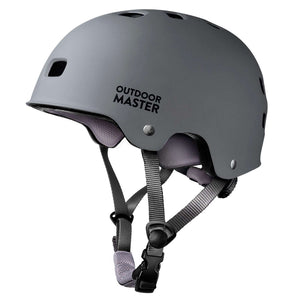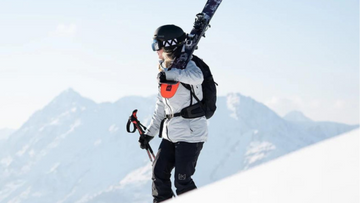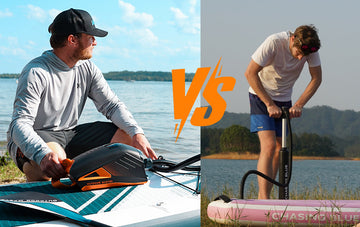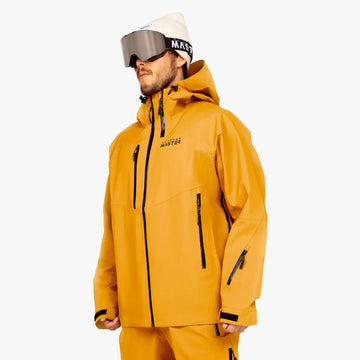
Inside this Article:
Outdoor activities such as skateboarding and cycling are fun, healthy, and accessible for people of all ages and skill levels. However, these activities also come with inherent risks, such as falls, collisions, and head injuries.
According to the Centers for Disease Control and Prevention (CDC), there are approximately 600,000 head injuries related to cycling each year in the United States, with nearly 1,000 of those being fatal.
Additionally, the CDC reports that approximately 6,000 people are treated in emergency rooms for skateboard-related head injuries each year. These statistics highlight the importance of wearing appropriate helmets while participating in these activities to help prevent head injuries and potentially save lives.
To reduce the risk of injury, it's essential to wear a proper helmet that meets safety standards and provides adequate coverage and protection. In this article, we will compare skateboard helmets and bike helmets and help you choose the right one for your activity.
Skate Helmet and Bike Helmet Comparison Table
|
Skateboard Helmets |
Bike Helmets |
|
|
Safety Standards |
ASTM F1492 or CPSC |
CPSC or EN1078 (International) |
|
Design and Construction |
Round, smooth, hard plastic |
Elongated, polycarbonate shell |
|
Coverage and Protection |
More coverage on back of head |
Longer back, visor |
|
Ventilation |
Fewer, smaller vents |
More, larger vents |
|
Weight and Comfort |
Heavier, less padding |
Lighter, more padding |
|
Similarities |
Hard outer shell and foam liner, adjustable straps, range of sizes |
|
Skateboard Helmet vs Bike Helmet: the Differences
Although skateboard helmets and bike helmets look similar at first glance, they have significant differences in safety standards, design, construction, coverage, ventilation, weight, and comfort.
Safety Standards
Skate helmets and bike helmets need to meet different safety standards. Skateboarding helmets typically meet the ASTM F1492 or CPSC safety standards, which focus on high-impact resistance, penetration resistance, and multi-impact protection. Biking helmets, on the other hand, must meet the CPSC safety standard or other international standards such as EN1078, which emphasize impact protection, ventilation, and aerodynamics.
Design and Construction
Skateboard helmets are typically rounder, smoother, and have fewer vents than cycling helmets. They also have a hard plastic shell and a dense foam liner that absorbs impact energy. Bike helmets have a more elongated shape, larger vents for air circulation, and a lighter and thinner foam liner. They also have a polycarbonate shell that covers more of the head and neck.
Coverage and Protection
Skate helmets and biking helmets differ in their coverage and protection. Skateboarding helmets cover more of the back of the head and have a lower profile to protect the ears and temples. They also have a thicker and more shock-absorbent foam liner that can withstand multiple impacts. Bike helmets have a longer back and a visor that shields the eyes from the sun and rain. They also have a thinner and lighter foam liner that's designed to protect against single high-speed impacts.
Ventilation
Skate helmets have fewer and smaller vents than cycling helmets, which can lead to overheating and discomfort during intense activities. Biking helmets have more and larger vents that allow air to circulate and cool the head, which is essential for long-distance cycling or racing.
Weight and Comfort
Skateboard helmets are typically heavier and bulkier than bike helmets, which can be uncomfortable for prolonged use or intense activities. They also have a snugger fit and less padding, which can cause pressure points and skin irritation. Biking helmets are lighter and more streamlined, with more padding and adjustable straps that provide a comfortable and secure fit.
Similarities between Skateboard Helmets and Cycle Helmets
In addition to their differences, skateboarding helmets and bike helmets also share some similarities. Both types of helmets are designed to protect the head from impact injuries and should be worn during their respective activities.
They are also made with a hard outer shell and a foam liner that absorbs impact energy. Additionally, both types of helmets have adjustable straps and come in a range of sizes to ensure a proper fit for the wearer
Choosing the right helmet for your activity is essential for your safety and comfort. Skateboard helmets and biking helmets have significant differences in safety standards, design, construction, coverage, ventilation, weight, and comfort, but both share the common goal of protecting your head from injury. Always make sure to choose a helmet that meets the appropriate safety standards for your activity and fits properly.
Why You Should Wear a Skate Helmet?

SKATEBOARD HELMET $29.99
Experience Ultimate Head Protection with Our All-Purpose Skateboarding Helmet - ASTM & CPSC Certified
Shop NowUSE CODE "OMBLOG20" FOR 10% OFF!
If you're a skateboarder, you should choose a skateboarding helmet for several reasons.
Protect your precious noggin: Skateboarding can be a blast, but it also involves a lot of falling, and hitting your head on concrete is no joke. A skate helmet is designed to protect your head from impacts and can help prevent serious injuries.
Look cool: Not only are skate helmets functional, but they can also be a fashion statement. With so many colors, designs, and styles to choose from, you can find a helmet that matches your personality and makes you feel like a badass.
Set a good example: Wearing a helmet sets a good example for others and shows that you take safety seriously. You can be a role model for younger skaters and help spread the word about the importance of helmet safety.
Increase confidence: When you're wearing a helmet, you can feel more confident and less worried about falling or getting hurt. This can help you focus on your skating and enjoy the ride.
To have more fun: At the end of the day, skateboarding is all about having fun. Wearing a skateboard helmet can give you peace of mind and allow you to focus on what's important – enjoying the ride and having a blast with your friends.
Why You Should Choose a Cycling Helmet?

GEM BIKE HELMET WITH MIPS SYSTEM $56.99
Looking for a top-notch cycling helmet with MIPS that does not break the bank? Look no further!
Shop NowUSE CODE "OMBLOG20" FOR 10% OFF!
If you're a cyclist, you should choose a bike helmet for several reasons.
Protect your precious noggin : Your brain is your most valuable asset, and you need to protect it at all costs. A cycling helmet will reduce the risk of a severe head injury in case of an accident, allowing you to ride with confidence.
Ride like the wind: A lightweight, aerodynamic helmet will reduce drag, allowing you to ride faster and farther without getting winded. Plus, you'll look like a pro cyclist with a sleek, stylish helmet on your head.
Stay cool and comfortable: A well-ventilated cycling helmet will keep your head cool and dry during long, hot rides. You won't have to worry about overheating or sweating through your helmet, which can be a major distraction when you're trying to beat your personal best.
Get in the zone: When you're riding, you want to be completely focused on the road ahead, not worrying about your safety. A properly fitting cycling helmet will stay securely in place, so you can focus on your form, breathing, and cadence.
Be a role model: When you wear a cycling helmet, you're setting a good example for other riders, especially kids. You're demonstrating that safety comes first, and that cycling can be a fun and healthy activity when done responsibly. So put on your helmet, hit the road, and show the world how much you love cycling!
Skateboarding Helmet FAQs
What is a skateboard helmet?
A skateboard helmet is a type of helmet that's designed specifically for skateboarding. Skateboard helmets typically have a hard plastic shell and a dense foam liner that absorbs impact energy.
What safety standards do skateboard helmets need to meet?
Skateboard helmets need to meet the ASTM F1492 or CPSC safety standards, which focus on high-impact resistance, penetration resistance, and multi-impact protection.
How should a skateboard helmetfit?
A skateboard helmet should fit snugly on your head, with the front edge of the helmet sitting just above your eyebrows. The helmet should not rock forward, backward, or sideways, and the chin strap should be securely fastened.
Can I use a bike helmet for skateboarding?
While it's possible to use a bike helmet for skateboarding, it's not recommended. Bike helmets are designed to protect against high-speed impacts, but they may not provide the same level of protection as skateboard helmets for repeated low-speed impacts and falls.
Bike Helmet FAQs
What is a bike helmet?
A bike helmet is a type of helmet that's designed specifically for cycling. Bike helmets typically have a polycarbonate shell and a foam liner that absorbs impact energy.
What safety standards do bike helmets need to meet?
Bike helmets need to meet the CPSC safety standard or other international standards such as EN1078, which emphasize impact protection, ventilation, and aerodynamics.
How should a bike helmet fit?
A bike helmet should fit snugly on your head, with the front edge of the helmet sitting just above your eyebrows. The helmet should not rock forward, backward, or sideways, and the chin strap should be securely fastened.
Can I use a skateboard helmet for cycling?
While it's possible to use a skateboard helmet for cycling, it's not recommended. Skateboard helmets may not provide the same level of protection as bike helmets for high-speed impacts and may not be as aerodynamic or ventilated.
Helmet Comparison FAQs
What are the primary differences between skateboard helmets and bike helmets?
The primary differences between skateboard helmets and bike helmets are in their safety standards, design, construction, coverage, ventilation, weight, and comfort.
Can I use a skateboard helmet for cycling, or vice versa?
While it's possible to use a skateboard helmet for cycling, or vice versa, it's not recommended. Skateboard helmets and bike helmets are designed for different activities and may not provide the same level of protection or comfort.
What type of helmet is best for multi-sport use?
If you participate in multiple sports, it's best to use a multi-sport helmet that's designed to meet the safety standards for each activity. Multi-sport helmets typically have a removable visor and padding that can be customized for each activity.
Can I wear a helmet designed for one activity for a different activity?
While it's possible to wear a helmet designed for one activity for a different activity, it's not recommended. Helmets are designed to meet the specific safety requirements and needs of each activity, and using a helmet for a different activity may not provide the same level of protection or comfort.
Conclusion
In conclusion, choosing the right helmet for your activity is essential for your safety and comfort. Skateboard helmets and bike helmets have significant differences in safety standards, design, construction, coverage, ventilation, weight, and comfort. If you're a skateboarder, you should choose a skateboarding helmet for its high-impact and multi-impact protection, coverage and protection, and style and customization. If you're a cyclist, you should choose a bike helmet for its impact protection, ventilation and aerodynamics, coverage and protection, and comfort and fit. Remember to always wear a helmet and check that it meets the appropriate safety standards for your activity.














